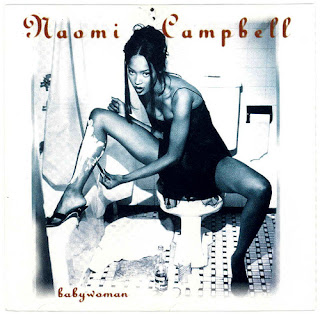 |
| Album cover: "Babywoman" |
Part of the fun in writing about pop art and high culture is acting as a cultural anthropologist. There are countless one-hit wonders in terms of music, books, films, and other media that at one point or another captured the public’s attention and may have been lost, forgotten, or just dimly remembered. What may have seemed like a gimmick or a high-concept lark may, in hindsight, prove to be highly-executed but misunderstood art, or just a bit of cheeky fun, as the Brits say.
Into the category of one-hit wonders falls supermodel Naomi Campbell’s 1994 album. Christened Babywoman, after one of her nicknames, Campbell’s album was an attempt to cash in on the British R&B-inflected dance music that was in vogue at the time. Artists popular at the time and to whom Campbell’s producers worked with and whose sound they emulated included M People, Eternal, Gabrielle and Soul II Soul.
 |
| The "Big Five", Vogue, January 1990 |
To understand the need of a supermodel to release an album, one had to recall the status in what became known as the era of the supermodel. From 1990 to about 1995, a small collection of the world’s top models gave rise to the term "supermodel". In particular, five were instantly immortalized in Herb Ritts’s iconic January 1990 cover of Vogue magazine. These women were the world’s top models, instantly recognizable and who were known by only their first names. They included Campbell, Cindy Crawford, Linda Evangelista, Christy Turlington and Tatjana Patitz. Known as “the Big Five”, they were joined by Kate Moss and became collectively known as “the Big Six”. Their presence immediately elevated the tone and marketability of any product, and they were in-demand by every conceivable designer on the planet. Their status, visibility and near-ubiquity had the residual effect of helping to make fashion one of the most high-profile and serious global industries. Campbell, Evangelista and Turlington in particular were such close friends and so sought-after that they became another subset of the “Big Six”: they were known as “The Trinity”.
It was in this cultural environment that the idea of the multi-hyphenate entertainer first appeared. Although it was not uncommon for actors to also direct and write films, plays, and TV at the time, it was unusual for models to attempt a career in the arts and in business at the same time that they modeled. It was with much media attention, tempered with a good deal of curiosity, that Campbell released her debut single “Love and Tears”.
 |
| Single cover of "Love & Tears" |
Critics were unkind. The ambient African-inflected dance track failed on the pop charts, spending a single week at a miserable No. 40 before fading into obscurity. Its parent album fared no better, stalling at No. 75 on the British album chart. Her primary audience consisted mainly of fashion-forward gay men, and the rest of the album is made up of dance floor fillers, but a lack of promotion and Campbell’s many other endeavours failed to give Babywoman much of a chance at success. Although her voice is serviceable, it is not exactly Maria Callas, or even Lady Gaga. Nevertheless, the ambient track is charming and is well-produced, and the album deserved much better than the baffling, continuing success of one Britney Spears.
 |
| Covering Japanese Vogue |
 |
| "I never look back, darling. It distracts from the now." - Edna Mode, The Incredibles |
 |
| Covering Russian Vogue |
And the Blogger hopes that one day, on a runway, the soundtrack blares Campbell’s “Love & Tears”, and see if she laughs, and remembers it fondly.